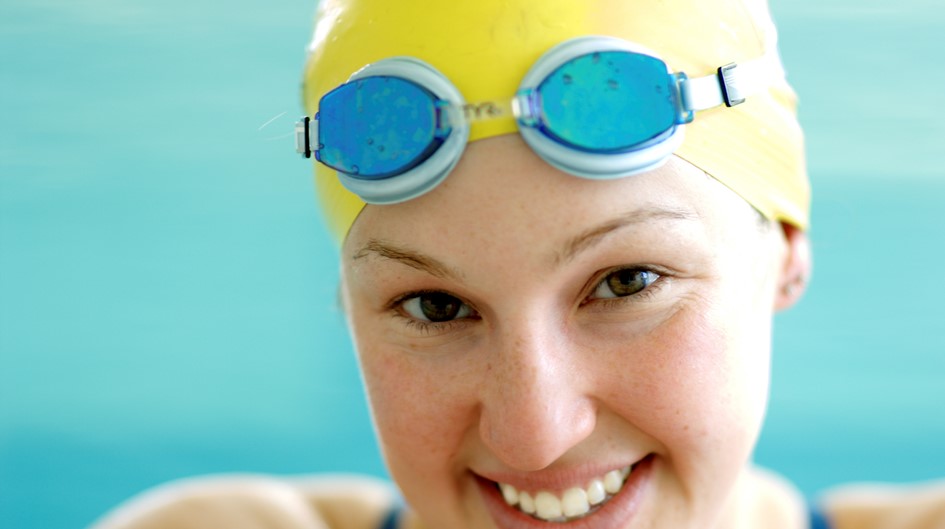|
There are so many brands of swimming goggles on the market nowadays, with a varying price range, but the best goggles are simply those that fit correctly and feel comfortable and stable on your face. You need to feel happy and confident that they will stay in place when swimming at your top speed. Many of the Strictly Swimming London coaching team have a high-level competitive swimming background and all will tell you how they had a favourite pair of goggles or ‘lucky goggles’ they felt helped them when racing (many of these goggles being the lowest price). So despite the price of the goggles you are trying on, always opt for those that fit the best and make your feel confident that they won’t bug you during your lessons, workouts and races. Getting the best fit with your swimming goggles Try on a few pair of swimming goggles to find a fit that suits you best. For some, children’s goggles may fit better than adult goggles. Hold the goggles to your face (without using the strap) and if you feel suction and they stay in place briefly, then they are most likely to be a good fit as you can feel a tight seal. If they fall off immediately, they won’t be a good fit and will hinder your swimming lessons and workouts. The main areas to check out when trying on a new pair of goggles are: Eye seal – After trying various pairs, opt for goggles that fit your eye socket size. With a good fitting pair of swimming goggles, you should feel even pressure around the eye sockets and seals the eyes well. Look at all eye socket types for men, women, all adults and even children’s goggles. Straps - The straps are used to keep your goggles in place but not to provide the seal. The strap should not be tightened so much that it makes the goggle uncomfortable and creates marks around your eyes, because it is too tight. When wearing a goggle with two straps, place the lower strap about eye level at the back of your head and position the other strap a couple of inches higher. This provides a secure fit and will help to prevent your goggles leaking or falling off when you dive into the water. Nose bridge – many goggles nowadays have an adjustable nose bridge to allow swimmers to personalise the fit and mould it to fit your face. Find a pair of goggles with a nose bridge that can be tightened or loosened to fit the with of your nose (without it affecting the placement of each goggle on your eye sockets). Pool Swimming or Open Water Swimming? If you are swimming in the sea or in open water, it is recommended that you opt for polarized swimming goggles. It is also important to find a pair of goggles which allow optimum peripheral vision when swimming in open water due to reduced visibility in unclear water. A wide medium to large frame will maximize your field of view in the open water, allowing you to ‘sight’ better when swimming in rough water. Swimming Goggles for Triathlon Whether you are contending with the glare of the sun, murky water or cloudy skies, it is worth spending some time thinking about your needs before you buy some goggles for your triathlon swim leg. Adult triathletes who opt for a full open-water mask will experience greater drag than a pair of small racing goggles. That may be true, but a small pair of goggles wouldn’t stand up well to a kick in the face at the start of a triathlon. A full wrap-around goggle is a common choice for open-water swimmers and triathletes, and there are definite benefits associated with the greater peripheral vision and more even distribution of pressure around the eyes through long swims. Goggles Keep Steaming Up Goggles fog up because warm, wet air, usually created from your body heat, condenses on the cooler-than-air lenses. However, if your goggles feature an anti-fog coating and still steam up, it could be their age. In some cases, with regular usage, goggles can out-live their anti-fog coating, depending on the method used to apply it during manufacture. If yours are fogging up and are old or well-used, it might be time to consider investing in a new pair. Avoid rubbing the lenses or touching them during your lessons and workouts, as this will start to remove the coating. Taking Care of Your Goggles Goggle maintenance is not an exact science but by following our hints and tips you should prolong the life of your goggles. All you need to do is wash the chlorinated water off your goggles after your lesson in warm water, air dry them rather than wiping them with a towel and store them carefully to avoid scratching the lenses. Comments are closed.
|
AUTHORPaul started competing in swimming from the age of 8 and eventually went on to represent his country all over the world. During his time at University, Paul specialised in Aquatics and the Biomechanics of Swimming and produced numerous theses on swimming performance. TOPICS
All
ARCHIVES
June 2024
|
Let's connect!
Copyright © 2024 Strictly Swimming


